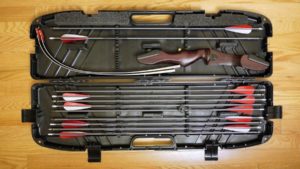Bows and arrows, once indispensable items for hunting or as military equipment, can now only be found in museums or as an accessory for extreme sports. A special case made of leather, wood or metal is used for carrying.
Arrow bag name
 The original Russian name is tul; it had the shape of a cylinder and was attached to the belt of a foot archer. For mounted warriors, a quiver became more relevant - a bag with internal partitions that help protect arrows from shaking and make it possible to quickly remove the arrow if necessary.
The original Russian name is tul; it had the shape of a cylinder and was attached to the belt of a foot archer. For mounted warriors, a quiver became more relevant - a bag with internal partitions that help protect arrows from shaking and make it possible to quickly remove the arrow if necessary.
Description of design
 A quiver is a bag, the cavity of which is divided into compartments according to the amount of contents. The material can be different: fabric or wood, leather or metal, options made of bamboo and willow twigs. Embroidery and metal rivets serve as decoration. For noble nobles, the quiver linings are made of precious metal; the distinctive sign is a coat of arms or ornament.
A quiver is a bag, the cavity of which is divided into compartments according to the amount of contents. The material can be different: fabric or wood, leather or metal, options made of bamboo and willow twigs. Embroidery and metal rivets serve as decoration. For noble nobles, the quiver linings are made of precious metal; the distinctive sign is a coat of arms or ornament.
The case is part of the saydak - the equipment of an equestrian warrior.The quiver itself also has a weatherproof cover called a tokhtui. How ornate the equipment is is an indicator of wealth or lack thereof.
Historical information about the bag for archers
 Initially, the tul was a round hard case for the weapons of a foot warrior. It was inconvenient, since the arrows were mixed up from shaking when walking, which made it difficult to immediately take one out if necessary.
Initially, the tul was a round hard case for the weapons of a foot warrior. It was inconvenient, since the arrows were mixed up from shaking when walking, which made it difficult to immediately take one out if necessary.
The quiver was borrowed from the Turkic peoples and was excellent for horse archers. It was performed in several versions; wealthy warriors wore two of them: a small one on their side, a large one behind their back. A spare bowstring, rolled into a roll, was usually attached to his belts.
Types of arrow bags:
- ebira – a case embroidered with fur;
- tsubo yanagui – a quiver in the shape of a jug;
- hira yanagui – flat bag.
In Scythia they used a type of quiver - it burns. This the case for the bow and arrows was most often made of wood and leather taken from the hand of a killed enemy. It was decorated with plates of precious metals and painted with bright colors and fastened with straps on the belt of a sword belt. Such a quiver consisted of two compartments: closer to the body - for a bow, and up to 180 arrows were placed on the outside.


 0
0





